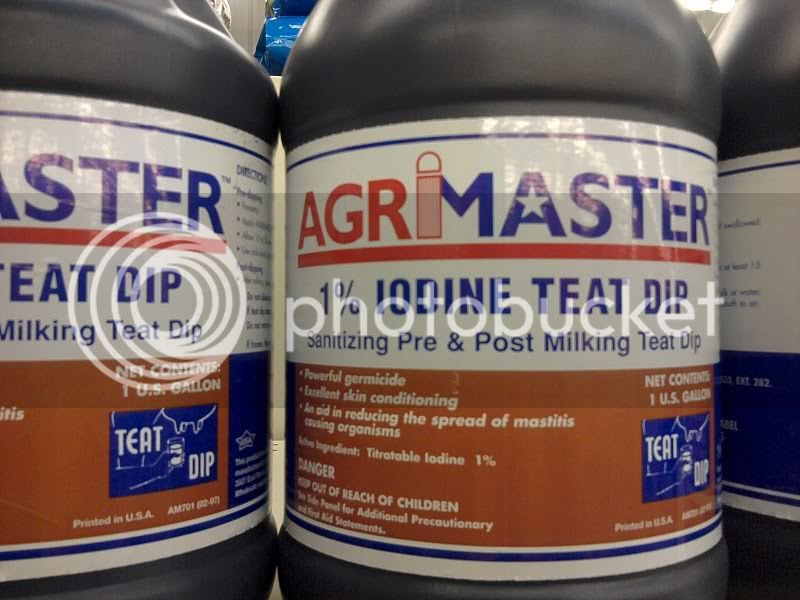I and quite a few others on here have been sucessfully using that for years. Like postal_penguin posted you just need to up the amount you use.
Iodophors have been used as sanitizers in the dairy industry forever, it was later that they were incoporated into brewing, and homebrewing specifically....
They don't call it iodophor in the dairy industry, they call it diary sanitizer or teat wash. Technically iodophor is a trade name I think owned by BTF, like xerox. Though Technically iodophors are;
An Iodophor is a preparation containing iodine complexed with a solubilizing agent, such as a surfactant or povidone (forming povidone-iodine). The result is a water-soluble material that releases free iodine when in solution. Iodophors are prepared by mixing iodine with the solubilizing agent; heat can be used to speed up the reaction.
But commonly when you go to a beer store you and ask for iodophor they will give you that. But in farm and feed you call it iodine sanitizer, teat wash, teat dip or something like that.
but it IS the same thing.
I get the stuff from tractor supply company by Dionne. It's much cheaper by the gallon than beerstore iodophor.
http://www.tractorsupply.com/livest...und-care/dionne-gentle-iodine-1-1-gal-2209723
The nice thing is that it foams up a bit like starsan when you add water to it.
Since it is used to meet the stringent safety requirments for milk processing/milk handling, it is more than suitable for our needs.
The standard dillution for 1.5% titratable iodine is 1 tablespoon/5 gallons. DIfferent brands will require a different dillution ratio.
This is a good breakdown of various iodophors and their dillution.
Iodophors
Postby DaaB on Tue Apr 15, 2008 6:50 pm
Iodophor and Betadine/Videne
Iodophor is a combination of iodine and an agent such as Povidone to make it water soluable.
Iodophor solution is dilluted with water and it releases free iodine, which is an effective bactericide and fungicide, it kills bacteria, mould and wild yeast that could spoil your beer.
Preperation: To make an effective no rinse solution it should be diluted to no less than 12.5ppm and no more than 25ppm. (more than 25ppm requires rinsing).
Below are the various dilution rates for the different brands of iodophor to produce solutions of 12.5ppm, they vary with the amount of free iodine in the iodophor product.
Dillution Rates (for 12.5ppm):
Betadine (1% free iodine) dillution is 1.25ml/l .
Videne (is a direct replacement for Betadine), suggest using as Betadine unless new info comes to light.
BTF iodophor (tbc not quoted or analysed) dillution is 0.78ml/l
Brupaks iodophor (analysed at 2.1% free iodine) dillution is 0.6ml/l
Instructions for use: The item being sanitised should be kept wet with an iodophor solution for 30 seconds or more then allowed to drip dry (or almost dry). Hand sprayers are ideal for wetting surfaces to be sanitised by iodophor.
Effectiveness: Iodophor's effectiveness can be approximated by it's colour. As long as the colour hasn't faded from that of the original preparation there is still the required level of iodine available for effective sanitisation.
When making a preparation of iodophor, filtered water is recommended (such as water that has passed through a Brita filter to remove chlorine and chloramines). Iodophor solutions made with filtered water have been shown to maintain their colour and therefore effectiveness for longer.
Tests have shown that the bactericidal activity (effectiveness) greatly reduces with an increase in ph. Solutions at ph 3-5 are significantly more effective than at ph7. If you live in a hard water area it is advisable to add 1 tsp of citric acid to the solution.
Iodophor solutions that are within the recommended ph range maintain their colour and therefore effectiveness for longer.
Brupaks iodohpor has already been acidified, although again people in hard water areas may find 1/2-1 tsp of citric acid is required to bring the ph to within the most effective range.
Cost: Brupaks Iodophor = £4.50 (17/04/08 ) for 250mls
0.6mls/l dillution = 416L of solution
This is also an invaluable article.
http://www.bayareamashers.org/content/maindocs/iodophor.htm
If you are lucky enough to find an iodine/phosphoric acid mix, which quite a lot of dairy sanitizers contain, it is even better. It is like having an iodophor/starsan mix.
But there's been lots of "go ahead" discussions about using it here, and on other forums as well.





















































![Craft A Brew - Safale S-04 Dry Yeast - Fermentis - English Ale Dry Yeast - For English and American Ales and Hard Apple Ciders - Ingredients for Home Brewing - Beer Making Supplies - [1 Pack]](https://m.media-amazon.com/images/I/41fVGNh6JfL._SL500_.jpg)






